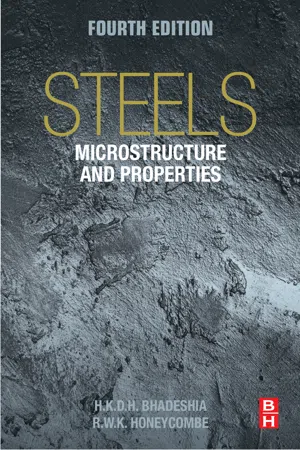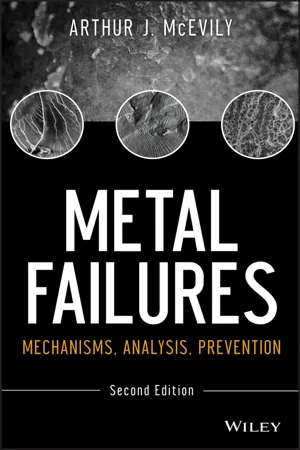Chemistry
Interstitial and Substitutional Alloys
Interstitial and substitutional alloys are two types of solid solutions in which atoms of different elements are mixed together within a metal lattice. In interstitial alloys, smaller atoms fit into the spaces between the larger host atoms, while in substitutional alloys, atoms of similar size replace the host atoms in the lattice structure. These alloy types can significantly alter the properties of the original metal.
Written by Perlego with AI-assistance
Related key terms
Related key terms
1 of 4
Related key terms
1 of 3
4 Key excerpts on "Interstitial and Substitutional Alloys"
- eBook - ePub
- Sir Alan Cottrell(Author)
- 2019(Publication Date)
- CRC Press(Publisher)
§ 4.6 ). This type of bond is largely indifferent both to the precise proportions of the component atoms and also to their precise distribution in the crystalline array of atomic sites. Random solutions over wide ranges of composition are thus possible.Solid solutions can be either substitutional or interstitial. As Fig. 6.2(a) shows, in a substitutional solution the atoms share a single common array of atomic sites. In interstitial solutions the atoms of one component are small enough to fit into the interstitial spaces between those of the other, which are themselves arranged in a complete crystalline array (Fig. 14.1 ).The equilibrium distribution of atoms in a substitutional solution generally depends on temperature. Various distributions are possible, ranging from the fully random state, which is most nearly obtained at high temperatures, to clustered (like neighbours preferred) and ordered (unlike neighbours preferred) states at lower temperatures. Short-range order, in which there is some tendency for unlike atoms to be neighbours but there is no long-range correlation in the distribution of atoms amongst the array of atomic sites, occurs fairly commonly. In addition, some alloys undergo a transformation below a critical ordering temperature to an ordered state in which a superlattice is formed by the regular alternation of unlike atoms through the entire crystal, or at least through large regions of it. A perfect superlattice is of course possible only at a critical and simple proportion of atoms, e.g. 1 to 1, or 3 to 1. Systems which form superlattices at such ratios also show imperfect superlattipes or long-range partial order at neighbouring compositions. Superlattices are found in both primary and secondary solutions. Some typical ones are shown in Fig. 14.2 .Fig. 14.1 An interstitial solid solutionFig. 14.2 - eBook - ePub
- H.K.D.H. Bhadeshia, R.W.K. Honeycombe(Authors)
- 2017(Publication Date)
- Butterworth-Heinemann(Publisher)
Chapter 4Solutes that Substitute for Iron
Abstract
If the wealth of structures available in the binary Fe-C is impressive, the addition of substitutional solutes creates a breathtaking variety of phases and structures, a seemingly endless palette that makes is feasible to custom design alloys of iron. The substitutional solutes influence the thermodynamics of all transformations, but have the most profound effect when they are required to diffuse. While all this is terribly useful, the complexity of the theory necessary to deal with multicomponent steels also increases, ameliorated by the availability of modern computer programs and databases. The understanding necessary to deal with such complexity is introduced so that the reader can make an intelligent use of the mathematical models that are implemented in the software.Keywords
Substitutional alloying; Austenite and ferrite stabilisers; Carbides and nitrides; Alloy pearlite; Interphase precipitation; Ledge mechanism4.1 General principles
The term alloying elements in the context of steels is often used to denote substitutional solutes, which can and do dramatically influence the structure and properties of steels. Indeed, they are responsible for the incredible versatility and utility of steels. The general effects of substitutional solutes are summarised in Fig. 4.1 and will be discussed in context throughout this Chapter. The solutes affect the relative free energies of the relevant phases, a thermodynamic effect that applies to all of the phase transformations irrespective of the detailed atomic mechanisms of transformation. New phases frequently appear, for example ϵ - eBook - ePub
Metal Failures
Mechanisms, Analysis, Prevention
- Arthur J. McEvily, Jirapong Kasivitamnuay(Authors)
- 2013(Publication Date)
- Wiley-Interscience(Publisher)
alloy. The main purpose in alloying is to increase the strength properties. Additional reasons for alloying include the improvement in corrosion resistance, wear properties, and performance at elevated temperatures. There are other reasons for alloying as well. For example, if sulfur is present in a steel, during heat treatment the sulfur atoms may diffuse to the grain boundaries and cause temper embrittlement. To prevent this from happening, manganese is added to the steel and the sulfur atoms combine preferentially with the manganese to form manganese sulfide particles, thereby reducing the tendency for embrittlement.Two types of common single-phase alloys are the substitutional and the interstitial. In a substitutional alloy, element A is replaced by element B on a lattice site. In an interstitional alloy, alloying elements such as H, C, N, and O are small enough to fit into spaces between lattice sites. Engineering alloys usually are made of a very large number of randomly oriented grains, each of which is a crystal; hence the term polycrystalline alloy. There are important exceptions however, such as the single crystals used in gas turbine engines of jet aircraft. Many other alloys are not single-phase alloys but may consist instead of two or more phases, as in the case of carbon steel, which consists of bcc -iron and an intermetallic compound, .III. Periodic Table
Fig. 5-1.The PeriodicTable of the Elements.Fig. 5-2.Unit cells. (a) Face-centered cubic (FCC); (b) hexagonal close packed (HCP); (c) body-centered cubic (BCC).IV. Phase Diagrams
The phase diagram is a starting point in understanding microstructure-property relationships. These diagrams show the composition limits of phase fields as they exist under metastable or stable conditions. The important phase diagrams that are considered in the next sections include those for the iron-carbon system, the aluminum-copper system, the titanium-aluminum system, and the nickel-aluminum system. In addition, the time-dependent aspects of the transformation in steels from austenite to ferrite, pearlite, bainite, or martensite are discussed. - eBook - ePub
Applied Welding Engineering
Processes, Codes, and Standards
- Ramesh Singh(Author)
- 2020(Publication Date)
- Butterworth-Heinemann(Publisher)
An alloy is a substance that has metallic properties and is composed of two or more chemical elements in which the primary one is a metal. A binary alloy system is a group of all alloys that can be formed by two elements combined in all possible proportions.Homogeneous alloys consist of a single phase, and mixtures consist of several phases. A phase is anything that is homogeneous and physically distinct if viewed under a microscope. When an allotropic metal undergoes a change in crystal structure, it undergoes a phase change.There are three possible phases in the solid state:- • Pure metal
- • Intermediate alloy phase or compound
- • Solid solution
Compounds have their own characteristic physical, mechanical, and chemical properties and exhibit definite melting and freezing points. Intermetallic compounds are formed between dissimilar metals by chemical valence rules and generally have nonmetallic properties; Mg2 Sn and Cu2 Se are examples of intermetallic compounds.Interstitial compounds are formed between transition metals such as titanium and iron with hydrogen, oxygen, carbon, boron, and nitrogen. They are usually metallic with high melting points and are extremely hard; TiC, and Fe3 C are examples of interstitial compounds.Electron compounds are formed from materials with similar lattice systems and have a definite ratio of valence electrons to atoms; Cu3 Si, and FeZn are examples of electron compounds.Solid solutions are solutions in the solid state and consist of two kinds of atoms combined in one kind of space lattice. The solute atoms can be present in either a substitutional or an interstitial position in the crystal lattice.There are three possible conditions for solid solution:- • Unsaturated
- • Saturated
- • Supersaturated
The solute is usually more soluble in the liquid state than in the solid state. Solid solutions show a wide range of chemistry, so they are not expressed by a chemical formula. Most solid solutions solidify over a range of temperature.
Index pages curate the most relevant extracts from our library of academic textbooks. They’ve been created using an in-house natural language model (NLM), each adding context and meaning to key research topics.
Explore more topic indexes
Explore more topic indexes
1 of 6
Explore more topic indexes
1 of 4



